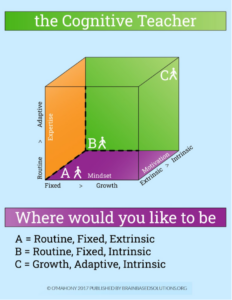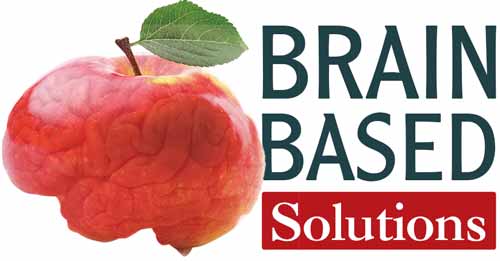Education turns out to be a three-legged stool. It is definitely wobbly at times. The three legs comprise teacher, student, and parent. Any one of these legs can let the other two down. If two are out of sync, the edifice unhinges and the center falls out.
In the past, we have made solid inroads into school systems and teaching circles with professional development programs that deliver new knowledge and ‘immediate and forever’ change. This kind of change is not easy since it invariably involves serious self-examination and results in paradigm shifts that are meaningful. In the case of a neural ed lens application to teaching and learning, this paradigm shift occurs on three planes at the same time and involves three cognitively arduous continuum shifts at the same time.
The X-axis is Mindset, demanding an onerous mental model that describes a shift from Fixed to Growth. The Y-axis is Expertise, demanding an equally onerous mental model that describes a shift from Routine to Adaptive to be in line with twenty-first-century living. The Z-axis is Motivation, demanding an even more exacting mental model that describes a shift from Extrinsic to Intrinsic.

Can you find yourself in this model? More importantly, can you see yourself shift along any of the axes as you reflect on your understanding of the three constructs – Mindset, Expertise, and Motivation. For most people, it is quite an eye-opener to even think about expertise as either routine or adaptive; it is interesting to see if they are fixed or growth in their mindset; and it is even more of a stretch to understand their connection to intrinsic motivation in a rigidly extrinsic world. After all, we have to work for pay; we have to think about rewards and punishments every day, and we have to react to how people show up in our varied social contexts.
The good news is this: it is possible to shift. It is easy to imagine a move along a continuum from routine to adaptive, and it is easy to want to be more growth as opposed to fixed. So, yes it is possible to move along the three axes and find yourself in a different space width regard to any of your work situations or your learning contexts.
Find yourself in the Cognitive Model
Many individuals who have been schooled in traditional Rewards and Punishments behaviorist models tend to find themselves congregated at the lower left-hand corner (Routine, FIxed, Extrinsic). In the wake of an immersive workshop with brain-based principles, these same individuals will see themselves shift towards the far right-hand corner (Growth, Adaptive, Intrinsic).
Future blogs will focus on each of the three constructs mentioned here – Mindset, Expertise, and Motivation. Take a deep breath… and plan ahead.

